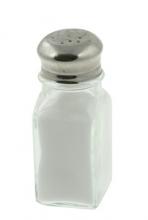A high sodium-potassium ratio appears to indicate a significantly increased risk of cardiovascular disease, ischemic heart disease, and all-cause mortality in the general population, according to a report in Archives of Internal Medicine.
A high sodium-potassium ratio was more strongly related to mortality than was a high sodium level alone or a low potassium level alone in a study of a large, nationally representative sample of adults. In addition, the robust association was independent of age, sex, race/ethnicity, and other variables, said Quanhe Yang, Ph.D., of the office of public health genomics at the Centers for Disease Control and Prevention, Atlanta, and associates.
"From a public health point of view, reduced sodium intake accompanied by increased potassium intake could achieve greater health benefits than restricting sodium alone," they noted (Arch. Intern. Med. 2011;171:1183-91).
The link between high sodium consumption and hypertension is fairly well known, but the public is less aware that low potassium levels are even more strongly related to hypertension. Several recent studies have suggested that the ratio of sodium to potassium is an even more important risk factor for hypertension and cardiovascular disease than either component alone.
Dr. Yang and colleagues analyzed these associations using data from the Third National Examination and Nutritional Health Survey (NHANES III). They estimated the usual dietary intakes of sodium and potassium at baseline for 12,267 adults participating in the survey, then determined the subjects’ mortality status during a median of 15 years of follow-up using the National Death Index.
During that time, there were 2,270 deaths, including 825 CVD deaths and 433 deaths from ischemic heart disease.
The risk of all-cause mortality increased linearly with increasing sodium-potassium ratio. The hazard ratio was 1.46 for the patients in the highest quartile of sodium-potassium ratio, compared with the lowest quartile.
A higher sodium-potassium ratio also was significantly associated with the risk of death from cardiovascular disease and from ischemic heart disease. The hazard ratios comparing the highest with the lowest quartiles were 1.46 for CVD mortality and 2.15 for ischemic heart disease mortality, the investigators said.
"We could not obtain the stable estimates for stroke mortality owing to the limited number of stroke deaths (139)," they added.
These associations were robust regardless of subjects’ sex, age, race/ethnicity, body mass index, hypertension status, physical activity level, or educational achievement.
"The observed stronger and more consistent association between the sodium-potassium ratio and mortality than between each nutrient separately and mortality may be due to complex interactions between potassium and sodium at cellular levels," the researchers said. "High sodium levels induce increased blood pressure and hypertension by stiffening endothelial cells, thickening and narrowing resistance arteries, and blocking nitric oxide synthesis, whereas higher potassium levels can counteract these effects by activating nitric oxide release."
The study findings indicate that public health recommendations "should emphasize simultaneous reduction in sodium intake and increase in potassium intake," Dr. Yang and associates said.
No financial conflicts of interest were reported.


